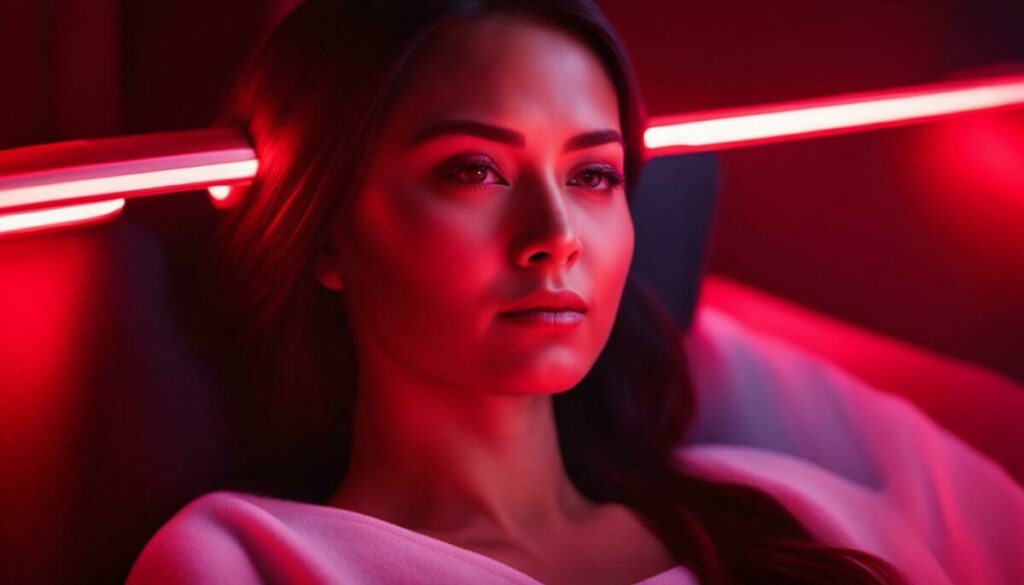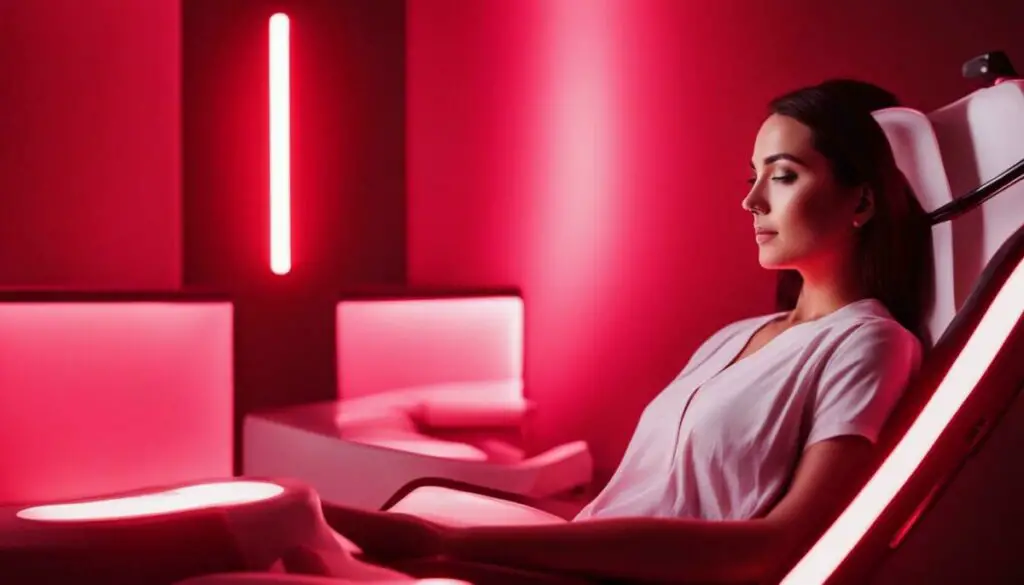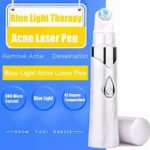Last Updated on 6 months by Francis
Red light therapy has gained popularity among individuals seeking to improve their overall health and wellness. This non-invasive treatment involves exposing the body to red light wavelengths, which are believed to stimulate cellular function and promote healing.
One common question among users is whether to keep their eyes open or closed during a red light therapy session. In this section, we will explore the benefits and considerations of using red light therapy with eyes open or closed, so you can make an informed decision for your therapy experience.
Contents
Key Takeaways:
- Red light therapy is a non-invasive treatment that uses red light wavelengths to stimulate cellular function and promote healing.
- When using red light therapy, individuals may choose to keep their eyes open or closed during the session.
- There are various benefits and considerations to using red light therapy with eyes open or closed, and it’s important to consider individual preferences and goals.
- It is essential to follow safety precautions when using red light therapy, particularly when it comes to eye health.
- Red light therapy may have potential benefits for improving vision and addressing specific eye-related concerns, as well as other health and wellness applications.
Understanding Red Light Therapy
Before exploring the best approach to using red light therapy with your eyes open or closed, it is important to grasp the concept of red light therapy and the benefits it offers.
Red light therapy, also known as low-level laser therapy (LLLT), utilizes red or near-infrared light to stimulate cellular functioning. This non-invasive treatment has been found to have various benefits, particularly in promoting tissue repair, reducing inflammation, and enhancing skin health. Additionally, it may aid in pain management, mood regulation, and recovery from physical exercise.
| Benefits of Red Light Therapy | |
|---|---|
| Improving skin health | – Reducing wrinkles, acne, and other blemishes |
| Promoting wound healing | – Accelerating tissue repair and reducing inflammation |
| Relieving pain | – Alleviating joint and muscle pain, reducing stiffness and spasms |
| Enhancing mood and sleep quality | – Regulating circadian rhythms and promoting relaxation |
Overall, red light therapy has the potential to improve the body’s natural healing processes and enhance overall well-being. Understanding the mechanisms behind this treatment can help inform the best approach for optimal results.

Red Light Therapy for Vision Health
Red light therapy has gained attention for its potential to promote overall vision health and address specific eye-related concerns. While the therapy is not a cure or substitute for medical treatments, it can serve as a complementary approach to support vision improvement and reduce the risk of certain eye conditions.
Multiple studies have suggested that red light therapy can stimulate the activity of specialized cells in the retina called photoreceptors. These cells are responsible for converting light into electrical signals that are transmitted to the brain for visual processing. By enhancing the function of photoreceptors, red light therapy may improve visual acuity and color discrimination, as well as reduce sensitivity to glare and improve contrast sensitivity.
In addition, red light therapy may have anti-inflammatory and antioxidant effects that can protect the eyes from damage caused by oxidative stress and inflammation. This can be particularly relevant for age-related eye conditions such as cataracts and age-related macular degeneration.
It is worth noting that the efficacy of red light therapy for vision health may depend on various factors, such as the individual’s age, overall health, and the severity of their vision impairments. Consult with a healthcare professional before starting red light therapy, especially if you have any underlying medical conditions or experience any discomfort or adverse reactions during the therapy.

If you are interested in using red light therapy for vision health, consider investing in a high-quality red light therapy device that emits wavelengths in the range of 600-700 nanometers, which are most effective for the eyes. You may also consult with a healthcare professional or a licensed red light therapy practitioner for guidance on the appropriate duration and frequency of therapy sessions.
Red Light Therapy for Eye Health
Red light therapy has been gaining popularity as a non-invasive and drug-free approach to improving overall health and wellness. One area where red light therapy has shown potential is in promoting eye health. By using specific wavelengths of red light, this therapy can stimulate cellular activity and circulation in the eyes, which may help maintain optimal eye function and reduce the risk of certain eye conditions.
Red light therapy for eyes has been shown to be a safe and effective method for addressing various vision concerns. One study found that red light therapy can help improve visual acuity, contrast sensitivity, and color discrimination in individuals with age-related macular degeneration (AMD), a common eye condition that can lead to vision loss.
Another study demonstrated the potential of red light therapy for reducing symptoms of dry eye syndrome, a condition characterized by inadequate tear production and discomfort in the eyes. Participants who received red light therapy reported a significant improvement in dry eye symptoms, such as burning, itching, and redness, compared to a control group.
| Benefits of Red Light Therapy for Eye Health | Red Light Therapy and Eye Conditions |
|---|---|
|
|
It’s important to note that red light therapy should not be used as a substitute for professional medical treatment or advice. However, it can complement existing eye care strategies and help improve overall eye health.

If you’re considering using red light therapy for eye health, it’s important to consult with a healthcare professional first. They can help determine if red light therapy is suitable for you, and provide guidance on the most effective and safe approach to using this therapy.
How Does Red Light Therapy Work?
Red light therapy, also known as low-level light therapy (LLLT), works by delivering specific wavelengths of light to the body’s tissues and cells. These wavelengths penetrate the skin and are absorbed by the mitochondria, the powerhouse of the cell, which then produces more energy in the form of adenosine triphosphate (ATP).
This increase in ATP production triggers a cascade of cellular processes that can promote various benefits, including accelerated tissue repair, reduced inflammation, and improved circulation.
Some studies suggest that red light therapy may also activate certain enzymes in the body that can stimulate the production of collagen, a protein that is essential for skin health and elasticity. This is why red light therapy is often used for skin rejuvenation and anti-aging purposes.

Overall, the therapeutic effects of red light therapy are thought to arise from its ability to stimulate the body’s natural healing processes, reduce oxidative stress, and modulate inflammation.
Using Red Light Therapy with Eyes Open
Red light therapy can be used with eyes open or closed, depending on individual preferences and treatment goals. While both approaches can be effective, using red light therapy with eyes open may offer some advantages.
One potential benefit of keeping your eyes open is that it allows the red light to penetrate the eyes directly, which can stimulate the retina and optic nerve. This may have a positive impact on vision and eye health, particularly in individuals with conditions such as macular degeneration or glaucoma.

Another advantage of using red light therapy with eyes open is that it allows for a greater sense of awareness and alertness during the session. Some users may find that keeping their eyes open helps them stay present and focused, which can be beneficial for managing stress or improving mental clarity.
However, there are also some considerations to keep in mind when using red light therapy with eyes open. It is important to avoid looking directly at the light source for prolonged periods, as this can cause eye strain or damage. Using protective eyewear may be recommended, especially for individuals with sensitive eyes or those undergoing longer sessions.
Overall, using red light therapy with eyes open can be a safe and effective way to enhance your therapy experience. Be sure to consult with a healthcare professional or eye care specialist to determine the best approach for your individual needs.
Using Red Light Therapy with Eyes Closed
Using red light therapy with your eyes closed can be a great way to enhance your relaxation and promote better sleep. Since red light therapy has been shown to improve melatonin production, it can be particularly helpful for individuals who struggle with insomnia or other sleep-related issues.
Moreover, keeping your eyes closed during red light therapy can help reduce eye strain and promote deeper relaxation. By removing visual distractions, you may be able to fully focus on the therapeutic effects of the red light.
When using red light therapy with your eyes closed, it’s important to choose a comfortable and relaxing environment. This can help you fully immerse yourself in the therapy experience and maximize its benefits. You may also want to consider using a sleep mask or eye pillow to further reduce any potential light leakage.
However, using red light therapy with your eyes closed may not be ideal for everyone, particularly if you have specific eye-related concerns. If you have any doubts or questions, consult with a healthcare professional before starting red light therapy.
Next, we’ll explore the pros and cons of using red light therapy with your eyes open.

Choosing the Best Approach for You
When it comes to using red light therapy, the question of whether to keep your eyes open or closed is a valid one. While both approaches have their benefits, it ultimately comes down to your personal preferences and therapeutic goals.
If you prefer to keep your eyes open during the therapy session, you can benefit from the added visual stimulation. This approach may be especially helpful if you’re using red light therapy to address specific eye-related concerns, such as dry eyes or eye strain.

However, be aware that using red light therapy with your eyes open may increase the risk of photobiomodulation-induced retinal damage (PRD) if the therapy device emits high levels of blue or green light. To mitigate this risk, consider using appropriate protective eyewear that blocks out blue and green light wavelengths.
On the other hand, using red light therapy with your eyes closed can create a more relaxing and meditative experience. This approach may be particularly useful if you’re aiming to improve your sleep quality or reduce stress levels.
Keep in mind that closing your eyes during the therapy can also reduce the potential benefits to the eyes themselves. If you want to maximize the eye-specific results of red light therapy, using the therapy with your eyes open may be a better approach.
Ultimately, the decision of whether to use red light therapy with eyes open or closed should be based on your individual needs and preferences. Consider the therapeutic goals you want to achieve and weigh the pros and cons of each approach to make an informed decision.
Safety Precautions for Red Light Therapy
Red light therapy is generally considered safe for most people, but taking some precautions can help avoid any potential risks, especially when applying it to the eyes. Here are some tips to ensure a safe and pleasant therapy experience:
- Use eye protection: To avoid any harm to the eyes, it is recommended to wear proper eye protection such as goggles or eye shields specifically designed for red light therapy. This is highly recommended if you are using high-intensity devices or exposing the eyes to red light for extended periods.
- Keep a safe distance: Ensure that the distance between the device and your eyes is appropriate as recommended. Distance varies depending on the device and its intensity, so always refer to the manufacturer’s instructions to avoid any risks.
- Get professional advice: If you have any underlying eye conditions or concerns, it is best to consult with an eye care professional before using red light therapy. This will help you determine if your condition allows for treatment and what safety precautions to take.
- Do not overdo it: As with any therapy, it is advisable not to overuse it. Too much exposure to red light can cause eye fatigue, dry eyes, or even damage the retina. Stick to the recommended duration and frequency, which may vary depending on your device and individual needs.
- Avoid using on sensitive skin: Do not apply red light therapy directly on or near sensitive skin or mucous membranes. This can cause discomfort, irritation, or hyperpigmentation.
By following these simple guidelines, you can enjoy the benefits of red light therapy while minimizing any risks or side effects. Stay safe and healthy!

Red Light Therapy for Improved Vision
Red light therapy has been found to potentially improve vision and enhance visual acuity. This therapy has been shown to stimulate the production of ATP, the energy currency of cells, and increase blood flow, which can be beneficial for eye health and function.
According to a study published in the Journal of Photochemistry and Photobiology, red light therapy may even be effective in treating age-related macular degeneration, a condition that causes vision loss in older adults.
“In this study, we demonstrate for the first time that photobiomodulation [red light therapy] can protect the retina from the damaging effects of Aβ peptides, suggesting its potential as a non-invasive therapy for AMD,” the authors write.
While more research is needed to fully understand the potential of red light therapy for vision improvement, preliminary findings are promising and point to its potential as a viable therapy for those looking to enhance their visual performance.

Red Light Therapy and Eye Conditions
Red light therapy has shown promise in potentially improving vision and addressing certain eye-related conditions. Here are a few examples:
| Eye Condition | Potential Benefit of Red Light Therapy |
|---|---|
| Dry Eyes | Red light therapy may help to reduce inflammation and stimulate tear production, leading to improved eye moisture and comfort. |
| Cataracts | While red light therapy cannot reverse the formation of cataracts, it may help to slow down their progression and improve vision quality. |
| Age-Related Macular Degeneration | Red light therapy may help to reduce inflammation and oxidative stress in the retina, potentially slowing down the damage caused by AMD. |
It’s important to note that red light therapy should not be used as a substitute for medical treatment or advice. If you are experiencing any eye-related symptoms or conditions, consult with your healthcare provider to determine the appropriate course of action.

Integrating Red Light Therapy into Your Eye Care Routine
If you are interested in incorporating red light therapy into your regular eye care routine, there are a few things to keep in mind. First and foremost, it is important to consult with your eye doctor or healthcare provider to ensure that it is safe for you to use this therapy, especially if you have any preexisting eye conditions or concerns. Your provider can help you determine the optimal duration, frequency, and intensity of red light therapy for your individual needs.
When choosing a red light therapy device, look for one that is specifically designed for eye health and has been approved by relevant regulatory bodies, such as the FDA. Some devices may come with additional features or accessories, such as protective goggles or an adjustable stand, that can enhance your therapy experience and ensure your safety.
To integrate red light therapy into your eye care routine, consider setting aside a dedicated time and space for your therapy sessions, such as in the morning or evening before bed. You may also want to combine red light therapy with other self-care practices, such as meditation or yoga, to enhance relaxation and overall well-being.
| Tip: | Try using red light therapy for a few weeks to gauge its effectiveness for your specific goals and concerns. Keep track of any changes or improvements you notice in your vision or eye health, and discuss them with your healthcare provider at your next appointment. |
|---|
By incorporating red light therapy into your eye care routine, you may be able to enhance your vision, reduce the risk of certain eye conditions, and promote overall eye health. However, it is important to use this therapy safely and responsibly under the guidance of a healthcare professional.

Potential Side Effects of Red Light Therapy
Red light therapy is generally considered safe and well-tolerated, but like any medical intervention, it may cause side effects in some individuals. Common side effects of red light therapy include:
- Skin irritation or rash
- Eye strain or fatigue
- Headache or dizziness
- Nausea or vomiting
It is important to note that these side effects are rare and typically mild in nature. However, individuals with sensitive skin or eyes may be more prone to adverse reactions.
When it comes to red light therapy and eyes, some experts recommend taking extra precautions to avoid potential harm. For example, wearing protective eyewear or keeping the eyes closed during treatment may reduce the risk of eye strain or damage.
It is also crucial to follow the manufacturer’s instructions carefully and not to exceed the recommended treatment duration or frequency. Overuse of red light therapy may lead to skin or eye damage and should be avoided.
If you experience any severe or persistent side effects after using red light therapy, you should discontinue treatment and consult with a healthcare professional. They can provide guidance on how to manage the symptoms and determine if any underlying health conditions may be contributing to the adverse reactions.

Other Uses of Red Light Therapy
While red light therapy has shown promising results for eye health and vision improvement, it also offers a range of benefits for other health concerns.
One popular application of red light therapy is in skincare. The therapy can help stimulate collagen production, reduce inflammation, and improve the overall appearance and texture of the skin. It may also be effective in treating acne, rosacea, and other skin conditions.
Red light therapy has also been used for pain management, particularly for chronic pain conditions such as arthritis, fibromyalgia, and back pain. The therapy can help reduce inflammation and stimulate the body’s natural healing processes, leading to pain relief and improved mobility.
For athletes and fitness enthusiasts, red light therapy can aid in muscle recovery and injury prevention. It can help reduce muscle soreness and inflammation, leading to faster recovery times and improved performance.
| Skincare Benefits | Pain Management | Sports Recovery |
|---|---|---|
|
|
|
With its wide range of potential applications, red light therapy offers a non-invasive and drug-free approach to improving overall health and wellness.

Red Light Therapy Devices
If you’re considering using red light therapy, you’ll need a device that emits the appropriate wavelengths of light. There are several types of red light therapy devices available on the market, ranging from handheld wands to full-body panels. Understanding the differences between them can help you choose the most suitable one for your needs.
Handheld Devices
Handheld red light therapy devices are small and portable, making them a convenient choice for targeted therapy. They typically have a small surface area and may require longer treatment times to cover larger areas of the body. Handheld devices may be powered by batteries or an electrical outlet.
Full-Body Panels
Full-body red light therapy panels are larger and cover a wider surface area of the body. They may require standing or lying down in front of the panel for treatment. These panels may be wall-mounted or freestanding, and some models come with wheels for easy movement. Full-body panels are typically more expensive than handheld devices but offer a more comprehensive therapy experience.
Desktop Devices
Desktop red light therapy devices are larger than handheld devices but smaller than full-body panels. They sit on a desk or table and may have an adjustable stand for different angles of treatment. Desktop devices are a good choice for targeted therapy and are often more affordable than full-body panels.

When choosing a red light therapy device, consider the size of the treatment area, the intensity of the light, and the cost of the device. Ensure that the device emits wavelengths of light that are appropriate for your specific therapy goals. Always follow the manufacturer’s instructions for safe and effective use.
Conclusion
Red light therapy can offer a wide range of benefits for both eye health and overall well-being. Whether you choose to use red light therapy with your eyes open or closed, it’s important to consider your personal goals and preferences to determine the most suitable approach.
By understanding the mechanism behind red light therapy and its potential effects on vision and eye health, you can make an informed decision about incorporating this therapy into your regular routine. Remember to follow important safety precautions, such as wearing appropriate eye protection and avoiding prolonged exposure.
Choosing the Best Approach
The decision to use red light therapy with your eyes open or closed ultimately depends on your individual needs and preferences. Some individuals may find it more comfortable to relax with their eyes closed, while others prefer to engage in visual activities during their therapy session.
Consider your specific goals for using red light therapy and experiment with both approaches to determine which one feels most effective for you. You may also want to consult with a healthcare professional or specialist to ensure you are using the therapy safely and effectively.
Emphasizing Individuality
Remember that there is no one-size-fits-all approach to using red light therapy, and what works best for one person may not work as well for another. Be patient and open to exploring different techniques and devices to find the right fit for your needs.
With a little experimentation, you can unlock the potential of red light therapy to improve your eye health, boost your overall wellness, and enhance your quality of life.
FAQ
Should I use red light therapy with my eyes open or closed?
The choice of whether to use red light therapy with your eyes open or closed is ultimately up to personal preference. Both approaches have their own benefits and considerations, so it’s important to find what works best for you.
What are the benefits of red light therapy?
Red light therapy has been shown to promote skin health, reduce inflammation and pain, improve circulation, and support overall well-being. It can also potentially enhance vision and eye health.
How can red light therapy benefit vision health?
Red light therapy may help improve visual acuity, reduce eye strain, and support overall eye health. It can be beneficial for individuals with conditions such as dry eyes, cataracts, or age-related macular degeneration.
How does red light therapy work?
Red light therapy works by stimulating the mitochondria in cells, which helps increase energy production and activate various cellular processes. This can lead to a range of therapeutic effects throughout the body, including improved vision and eye health.
What are the advantages of using red light therapy with eyes open?
Using red light therapy with your eyes open allows for direct exposure of the eyes to the therapeutic light. This can potentially enhance vision improvement and provide targeted benefits to the eyes.
What are the benefits of using red light therapy with eyes closed?
Using red light therapy with your eyes closed can promote relaxation, reduce eye strain, and help improve sleep quality. It allows for a more immersive and soothing experience.
How do I choose the best approach for me?
When deciding whether to use red light therapy with your eyes open or closed, consider your specific goals and preferences. If you are targeting vision improvement or eye-related concerns, using it with eyes open may be more beneficial. If relaxation or better sleep is your focus, using it with eyes closed may be preferable.
What safety precautions should I follow when using red light therapy?
It’s important to protect your eyes during red light therapy sessions. Use appropriate eye protection or keep your eyes closed to avoid direct exposure. If you have any underlying eye conditions or concerns, consult with a healthcare professional before starting red light therapy.
Can red light therapy improve vision?
While red light therapy has shown potential in improving visual acuity and addressing certain eye conditions, individual results may vary. It can be used as a complementary strategy alongside other vision support techniques.
Are there any side effects of red light therapy?
Red light therapy is generally considered safe when used correctly. However, some individuals may experience mild side effects such as temporary eye discomfort or skin sensitivity. If you experience any adverse reactions, discontinue use and consult a healthcare professional.
What are some other uses of red light therapy?
In addition to its potential benefits for eye health, red light therapy is widely used for skincare, pain management, sports recovery, and overall wellness. It has diverse applications across various fields.
What types of red light therapy devices are available?
There are various types of red light therapy devices, including handheld devices, light panels, and full-body systems. When choosing a device, consider factors such as the intensity of light, wavelength range, and specific features that align with your needs.









